|
[For the
uninitiated, a 'blog' (or weblog)
is a web journal with links. This gives me a chance to add short, 'off the record' style items that
wouldn't merit a separate article. I try my best to keep entries informal,
frequent, brief and (hopefully) interesting. For more information
about Jamie Goode, see the about the author
section.]
Friday 23rd December
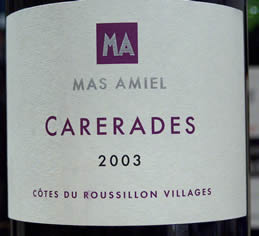 Tonight
has a distinctly Roussillon flavour to it. I began with the Mas
Amiel Carerades 2003 CŰtes du Roussillon Villages. This is a
bruiser of a wine. Along with the pure, intense, perfumed red and
black fruits there's a whack of tannin and good acid. It's a
concentrated new-wave Roussillon red with a lot going for it, but with
its massive structure, you need to approach this with food. The
Roussillon is on a bit of a roll at the moment, It missed out on the
Languedoc revolution, but now it is playing catch-up, as evidenced by
the likes of Eric Monnier's Clot
de L'Oum and Domaine
Matassa, both reviewed here. When these old vine vineyards get
into the hands of people with ambition, the results can be quite
exciting. Tonight
has a distinctly Roussillon flavour to it. I began with the Mas
Amiel Carerades 2003 CŰtes du Roussillon Villages. This is a
bruiser of a wine. Along with the pure, intense, perfumed red and
black fruits there's a whack of tannin and good acid. It's a
concentrated new-wave Roussillon red with a lot going for it, but with
its massive structure, you need to approach this with food. The
Roussillon is on a bit of a roll at the moment, It missed out on the
Languedoc revolution, but now it is playing catch-up, as evidenced by
the likes of Eric Monnier's Clot
de L'Oum and Domaine
Matassa, both reviewed here. When these old vine vineyards get
into the hands of people with ambition, the results can be quite
exciting.
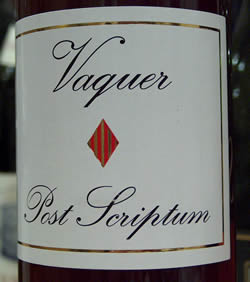 Then
it was time for something sweet. Vaquer's Post Scriptum 1995
Rivesaltes is a Vin Doux Naturel that's like a good tawny Port in
character. It shows lots of warm, sweet, spicy fruit with a subtly
raisined, casky character. It's a deliciously balanced wine with some
evolution (this was from a half-bottle) and a fair bit of complexity.
I'd say that this mellow wine is in a more traditional style than the
Mas Amiel, but both have their place. Regions like the Roussillon have
huge untapped potential: in the past they have focused on quantity at
the expense of quality, but there's no reason why most of the
vineyards in this large region shouldn't be able to achieve high
quality, given the desire to do so on the part of the winegrower. Part
of the secret is that these are vineyards with naturally quite low
vigour, almost always a good thing where quality is concerned. Then
it was time for something sweet. Vaquer's Post Scriptum 1995
Rivesaltes is a Vin Doux Naturel that's like a good tawny Port in
character. It shows lots of warm, sweet, spicy fruit with a subtly
raisined, casky character. It's a deliciously balanced wine with some
evolution (this was from a half-bottle) and a fair bit of complexity.
I'd say that this mellow wine is in a more traditional style than the
Mas Amiel, but both have their place. Regions like the Roussillon have
huge untapped potential: in the past they have focused on quantity at
the expense of quality, but there's no reason why most of the
vineyards in this large region shouldn't be able to achieve high
quality, given the desire to do so on the part of the winegrower. Part
of the secret is that these are vineyards with naturally quite low
vigour, almost always a good thing where quality is concerned.
Wednesday 21st December
Good news for all those who suffer from SAD (seasonal affective
disorder): the shortest day of the year has passed, and from now on it
will start getting light earlier and dark later (at least for those of
us in the northern hemisphere). Christmas is just a few days away -
whoever chose to put Christmas where they did in the calendar was a
genius because without a holiday to look forward to in this, the most
miserably dark part of the year, it would be harder to bear these long
winters we Brits endure. Christmas is also welcomed by the drinks
trade because they know that far too much of their product will be
consumed at this time.
These
are the recommendations for Christmas day wines that I made in my Sunday
Express column. The actual text will have been modified somewhat
by the subs, who usually do a very good job.
Sainsburyís
Taste the Difference 12 Year Old Oloroso Sherry
£6.99
Sainsbury
Begin the day in civilized fashion with a wonderfully complex sherry.
You can have a glass of this deliciously moreish tipple while you are
opening the presents. I particularly like the way the raisiny richness
is backed up by evocative smells of old furniture and the long, dry,
spicy, casky finish.
Champagne
Oudinot NV
Marks
& Spencer
Then itís time to start on the fizz. Most people tend to have a
glass of Champagne as an apertif, but it actually makes a wonderful
companion all the way through lunch, if thatís what you feel like.
This is delightfully crisp and fresh, with lovely fine bubbles and a
nice acidic backbone. Great value at the offer price.
Anakena
Ona 2003 Rapel Valley, Chile
An
almost overpoweringly full flavoured luvvie of a white wine, which
successfully blends together three grapes that normally do their own
thing: Chardonnay, Riesling and Viognier. They are held together here
with some seductive spicy oak, and the result is a big wine that has
broad flavours of lime, sweet honeydew melon, herbs and vanilla. Great
with a traditional Christmas dinner. (£8.99 Oddbins)
M‚con
Terroir de Charnay 2004 Domaine Cordier
This
weighty, sophisticated white Burgundy is another brilliant Christmas
lunch wine. The perfect turkey wine? Quite a deep colour, it has a
rich, herby, nutty nose that leads to a thick fruity palate with notes
of pear, grape skin, melon and herb. Itís a grown up Chardonnay
thatís learned to fend for itself. Very satisfying. (£8.99
Majestic. £7.99 if you buy two)
Zonteís
Footstep Shiraz Viognier 2004 Langhorne Creek, Australia
A
dark, sleek red wine with a lovely perfumed blackcurrant and raspberry
fruit nose. Itís pure, intense and inviting. The palate is dominated
by vivid fruit. Pure, supple and quite intoxicating. (£7.99 Sainsbury)
Ch‚teau La Vieille Cure 2000 Fronsac, Bordeaux
£14.99 Sainsbury
£15 is a lot of money to pay for a wine, but heck, itís Christmas.
And you can actually spend a lot more in Bordeaux, which is possibly
the worldís worst value for money region, and come away with a wine
thatís only half as good as this. Deep coloured, it shows lovely
tight, earthy blackcurrant fruit. Evolving very nicely, you could
cellar this one for another 10 years, but itís delicious now.
Matahiwi
Estate Pinot Noir 2004 Wairarapa, New Zealand
£8.99
Oddbins
Pinot Noir, the red grape of Burgundy, is the sort of variety that
frustrates just as often as it delights. Here it works brilliantly,
producing a beatifully perfumed wine that matches its vibrant dark
cherry fruit with a lovely savoury, spicy, undergrowth-like character.
Itís worryingly easy to drink and is the sort of lighter red that
would work well with turkey.
Muga
Rioja Reserva 2001 Spain
A
wonderful traditionally styled Rioja red, with lovely earthy, spicy
complexity to the warm, slightly sweet fruit. Itís fine and
expressive, with a lovely mellowness countered well by lively spice
and acidity. A nicely savoury wine that will work with a wide range of
foods, but which is also perfect for sipping contemplatively. (£9.99
Co-op)
Sichel
Sauternes 2002 Bordeaux, France
After
the main course, why not spoil yourself with something sweet? This is
a good example of Sauternes, the classic sweet white wine that owes
much of its character from letting the grapes rot on the vines. Sounds
foul, but the benign Ďnoble rotí results in a rich, viscous wine
with lovely sweet melon and apricot flavours, together with a nice
spicy complexity. Goes wonderfully with cheese, too. (£8.99 for 50 cl,
Morrisons)
Warreís
Late Bottle Matured Late Bottled Vintage Port 1994 Portugal
The
perfect way to finish the day is in the company of a very good Port,
and hereís a serious example that punches well above its weight.
Itís dark, with a delicious savoury spiciness running counter to the
sweet blackcurrant fruit, adding an extra dimension to the flavour.
Itís drinking very nicely now, but will probably mellow to a
graceful elegance with a few years more cellaring. Tesco have the 1995
Vintage, which is almost as good, for a similar price.
(£15.49 Waitrose)
Sunday 18th December
Like anyone who is seriously into wine, I have a problem Ė I
have a tendency to buy more of the stuff than I drink. Assuming you
havenít got a drink problem, then thereís an upper limit (which I
guess isnít strictly defined, although I suppose it is no more than
a bottle, and probably a bit less, per night) to what one can consume.
Yet I perpetually find myself buying more than this. Most people
disguise their over-buying by calling it a cellar. And thereís a
degree of legitimacy to this: if you are buying the sorts of wines
that need five years cellaring, then at any one time youíd expect to
have five times your annual consumption of these wines in stock at any
one time. But I know people who are in their 50s with 10 000 bottles
in their cellar. Do the maths.
Iíve not got a big cellar. Iíve deliberately
restricted myself from spending too much on wine. Since I took the Sunday
Express job, though, Iíve run into the problem of having
enormous numbers of samples to wade through. Iím conscientious with
my samples and try them all, drinking some and pouring many. It does
mean that Iím buying fewer wines myself, though. This carries its
own dangers. By drinking wines you havenít paid for, thereís a
subtle shift in perspective. Itís good to be in the shoes of the
people you are writing for, who have shelled out their own hard-earned
cash on wine. So as a deliberate discipline, from time to time I go
out and buy wines just as my readers do. Iím then looking for these
wines to deliver value for money. Itís a lot easier to be
appropriately critical of a £20 wine when youíve paid for it, than
when some PR has sampled it to you. Suddenly, wines have to deliver.
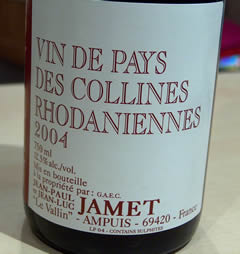 On Saturday evening I went wine shopping while one of
my sons was at a party. In Oddbins, I picked up two wines. First, the 1999
Quinta do Noval LBV, which for £9.99 (reduced by a pound), is a
stunning value. Iíve tried this wine before (as a sample) and liked
it so much I wanted it as one of my Christmas tipples. Then the Ben
Glaetzer Heartland Dolcetto Lagrein 2004 from the McLaren Vale
in South Australia. [Oddbins is onthe up, I reckon - the range is
getting stronger after a bad patch.] I couldnít resist an Aussie
interpretation of these two Italian varieties, particularly one by a
superstar like Ben. Itís a really nice wine, and a relatively good
value at £8.99. In Majestic I bought a mixed case containing: (1) two
bottles of Yering Frog Pinot Noir 2005 (£5.99 each), (2) two
bottles of Yalumba Y Viognier 2005 (£5.59 each), (3) two
bottles of Lindauer Rosť Brut NV (£5.99 each), (4) a bottle
of De Bortoliís Show Reserve Liqueur Muscat NV (£8.99) and
(5) five bottles of Jametís Syrah Vin de Pays des Collines
Rhodaniennes 2004 (£6.49). This last wine is fantastic, and if I
had a house red this would be it. Itís the essence of northern RhŰne
Syrah: light, peppery, slightly meaty, fruity and savoury Ė
dangerously easy to drink. Iíd have bought three cases if I wasnít
already sitting on a pile of wine that needs drinking soon-ish. On Saturday evening I went wine shopping while one of
my sons was at a party. In Oddbins, I picked up two wines. First, the 1999
Quinta do Noval LBV, which for £9.99 (reduced by a pound), is a
stunning value. Iíve tried this wine before (as a sample) and liked
it so much I wanted it as one of my Christmas tipples. Then the Ben
Glaetzer Heartland Dolcetto Lagrein 2004 from the McLaren Vale
in South Australia. [Oddbins is onthe up, I reckon - the range is
getting stronger after a bad patch.] I couldnít resist an Aussie
interpretation of these two Italian varieties, particularly one by a
superstar like Ben. Itís a really nice wine, and a relatively good
value at £8.99. In Majestic I bought a mixed case containing: (1) two
bottles of Yering Frog Pinot Noir 2005 (£5.99 each), (2) two
bottles of Yalumba Y Viognier 2005 (£5.59 each), (3) two
bottles of Lindauer Rosť Brut NV (£5.99 each), (4) a bottle
of De Bortoliís Show Reserve Liqueur Muscat NV (£8.99) and
(5) five bottles of Jametís Syrah Vin de Pays des Collines
Rhodaniennes 2004 (£6.49). This last wine is fantastic, and if I
had a house red this would be it. Itís the essence of northern RhŰne
Syrah: light, peppery, slightly meaty, fruity and savoury Ė
dangerously easy to drink. Iíd have bought three cases if I wasnít
already sitting on a pile of wine that needs drinking soon-ish.
Saturday 17th December
Two more book reviews have appeared, one by Natasha Hughes in Off
Licence News which isnít online, and a nice one from Neal Martin
on www.wine-journal.com.
Nealís is particularly welcome because itís thoughtfully written,
like most of his material. Overall, Iím amazed by how well the book
has been received Ė while you always like to believe what youíve
done is good, itís nice to have some third party perspectives.
Anyway, enough of the tireless self promotion. Back to the wine.
Recent
hits have included a really nice honest Crozes Hermitage 2003 from
Cave de Tain, which is available in Sainsbury for £6.99. It's just
what you want from affordable northern RhŰne Syrah: fresh, bright,
peppery, some raspberry fruit and a hint of meatiness. Very drinkable
- the sort of bottle that performs well at table and disappears
quickly. I think M&S's Crozes 2003 is from the same producer, but
it's a bit pricier.
Wednesday 14th December
Two more book reviews. Both nice, by two of my favourite wine
writers.
Tim Atkin in The Observer
observer.guardian.co.uk/magazine/story/0,11913,1663837,00.html
Wine Science by Jamie Goode (£30, Mitchell Beazley) *****
(One of only two books in Timís line-up to get five stars)
'This isn't the cheapest wine book on the shelves, and its paucity of
illustrations gives it a rather forbidding, academic look. But to a
scientific ignoramus like me it's the most useful book of the year,
packed with fascinating, well-researched information about everything
from genetically modified vines to wine allergies, cork taint to
micro-oxygenation. Goode is a rarity - a scientist who knows how to
explain his subject in an approachable way.'
Andrew
Jefford in The Evening Standard
'Jamie Goodeís Wine Science (Mitchell Beazley, £30) is less
diverting but more technically detailed. Goode has a PhD in plant
biology complemented by an invaluable training as a science editor,
and has no rival at all among wine writers in terms of his grasp of
the science underlying wine production. He puts it over in terms even
I can understand, so you will have no trouble at all. The results,
surprisingly, can be juicy as a good Juliťnas.'
Saturday 10th December
Two sparkling wines last night, both quite different, both
delicious. First up, Champagne Le Mesnil Grand Cru Blancs de Blancs
NV. Lots of finesse and a fair bit of complexity, with a savoury,
oaty richness backing up the bright fruit. This is pretty serious
stuff with very good balance. In complete contrast, Peter Lehmann's
1997 Black Queen Barossa Sparkling Shiraz, which shows bags of
sweet strawberry and blackcurrant fruit sitting on top of some earthy,
spicy complexity. It's a little gamey, too, and I reckon this will
age.
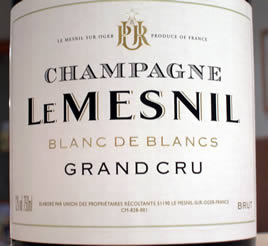 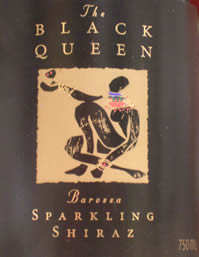
Friday 9th December
Reviews of my book are starting to appear. Fortunately, so far people
seem to like it.
Eric
Asimov in the New York Times
ĎFinally, while wine producers love to portray themselves as
humble artisans, winemaking these days is a complicated process that
cannot always be understood intuitively. Fortunately, Jamie Goode's
new book, The Science of
Wine: From Vine to Glass (University of California
Press, $35, available next month, explains some of the terms that
critics toss around, like reverse osmosis and cane-pruning, while
asking (and trying to answer) common-sense questions, like how much
manipulation is acceptable in winemaking and whether a wine can taste
like minerals. These could be dull topics, but Mr. Goode manages to
make them lively and provocativeí
Joanna
Simon in The Sunday Times
Wine: Tips for tipplers
Joanna
Simon raises a glass to some authoritative tomes, a witty
stocking-filler and a memoir from Hugh Johnson in her selection of the
yearís best books on drink.
WINE
SCIENCE: The Application of Science in Winemaking by Jamie Goode
Mitchell Beazley £30
Should he ever need to, Hugh Johnson could use this book to support
his view that tasting notes citing all sorts of fruits end up being
meaningless. Studies show that even experienced tasters canít detect
more than four odours in a mixture. Fortunately, as a wine writer
himself Goode cannot afford to be too hard on us scribes: we write
tasting notes because ďitís the best we can manage, so it will
have to doĒ. Quite so. This scholarly yet accessible work is an
invaluable source for the technicalities of vineyard, winery and
tasting.
Anthony
Rose in the Inependent
Raise a glass to the future of wine
By Anthony Rose
ĎSince time
immemorial the natural bloom on the grape kick-started fermentation
and lo, with a bit of intervention to stop it souring into vinegar, we
had wine. Today, as white-coated boffins bring problems of oxidation,
volatile acidity, reduction and cork taint within their sights,
science is moving into the realms of science-fiction. The Portuguese
have developed robot treaders to replace human beings. In France,
where genetically modified crops are derided by protesters as
Frankenfoods, experiments have been authorised for GM vines to halt
the spread of the fanleaf virus that attacks vine roots. A
biotechnologist at Stellenbosch University claims GM wines might
prevent hangovers.
In the cellar,
sulphur dioxide (to neutralise bacteria), filtering and cooling
technology are part and parcel of the modern winemaker's bag of
tricks. If a wine is over-alcoholic because of a new vine clone or
yeast strain, technology can ride to the rescue in the form of
alcohol-reducing methods such as reverse osmosis or spinning cone
technology. Jamie Goode's
recently published, stimulating and highly approachable Wine Science (£30, Mitchell Beazley) will explain all.í
Tuesday 6th December
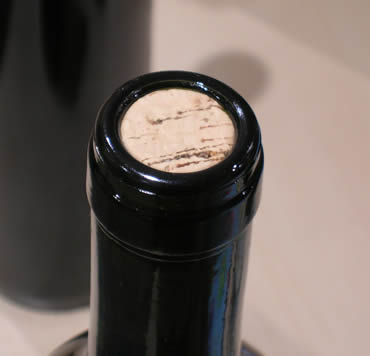 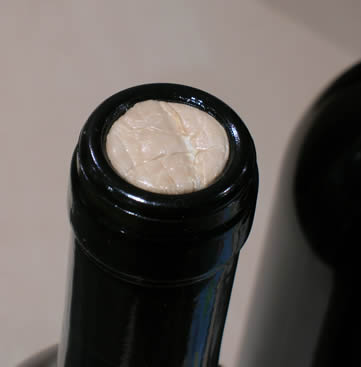
Met with Gregor Christie of Australian company ProCork
last night. ProCork is an innovative solution to the problems of cork
taint and random oxidation that could prove to be corkís salvation.
How does it work? If youíll forgive the analogy, itís a condom for
cork. A transparent, thin five-layer membrane, robustly attached by a
heating process to both ends of the cork (we don't know which end will
end up in contact with the wine), it prevents a TCA-tainted cork from
infecting the wine, while acting as an oxygen barrier. The result is a
natural cork that seals just a little tighter than the average cork,
but not tightly enough to cause reduction problems. The pictures show
a bottle sealed with an untreated cork and a ProCork treated cork; the
latter (right) has a slightly shiny appearance to it. So far, in
Australia 50 million bottles have been sealed this way, roughly a
fifth the number that are screwcapped Ė many are coming in under the
radar. Itís an impressive statistic considering that the product has
only been on the market 10 months. Gregor is now launching in Europe.
Itís early days, but it does seem a promising solution to the cork
malady that enables those who want to, to stick with natural cork.
Sunday 4th December
On the way back from a sunny South Africa, where it's 30 įC and
blazing sunshine, to the rather less benign UK winter. The measure of
a good trip? It's how much I've learned. And by this criterion, the
last four days have been very profitable. I've learned a lot on this
trip and met some interesting and pleasant people. As an aside, I had
a nice surprise today in a bookshop in Stellenbosch (see below).
Mitchell Beazley must be doing a good job for me. It was double the
amazon price, though.
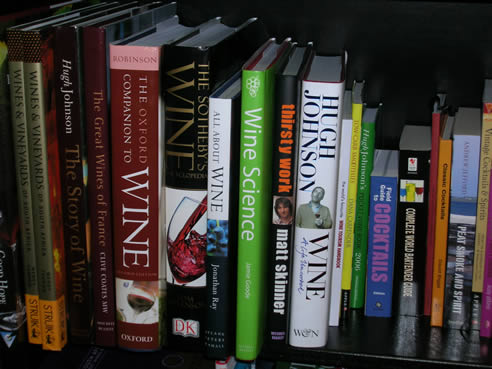
Saturday 3rd December
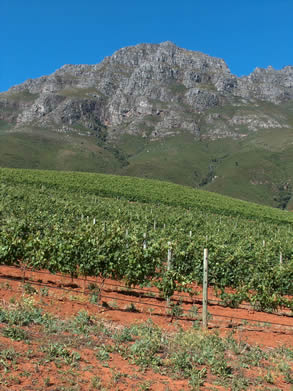 I've
been flat out in the Cape winelands for the last three days, and now -
with a producer pulling out of a tasting without giving me any notice
- I have some time to key in a quick update. What's happening here in
the South African wine scene is quite exciting, and the pace of change
is electric. Remember, for all intents and purposes this is a young
industry. Forget the 300 year history - the modern winemaking scene
here is just over a decade old. Particularly interesting is the rise
of regionality as a theme, and the way that young winemakers with
ambition, ability and international experience are now finding their feet. I had a great dinner
last night with Sadie, Scali and Lammershoek - three producers who are
exploring the identity of Peederberg, a sub region in the Swartland
appellation. I've met some really interesting people, including stars
such as Andre van Rensberg, Charles Back, Ken Forrester, Bruce Jack,
Neil Ellis and Marc Kent. It's been beautiful spending time seeing
vineyards, too, in gorgeous sunny weather. I've almost filled my
notebook; my digital camera is steaming. And tonight I fly back - it's
been a good trip. Too many great wines to mention, so more later. I've
been flat out in the Cape winelands for the last three days, and now -
with a producer pulling out of a tasting without giving me any notice
- I have some time to key in a quick update. What's happening here in
the South African wine scene is quite exciting, and the pace of change
is electric. Remember, for all intents and purposes this is a young
industry. Forget the 300 year history - the modern winemaking scene
here is just over a decade old. Particularly interesting is the rise
of regionality as a theme, and the way that young winemakers with
ambition, ability and international experience are now finding their feet. I had a great dinner
last night with Sadie, Scali and Lammershoek - three producers who are
exploring the identity of Peederberg, a sub region in the Swartland
appellation. I've met some really interesting people, including stars
such as Andre van Rensberg, Charles Back, Ken Forrester, Bruce Jack,
Neil Ellis and Marc Kent. It's been beautiful spending time seeing
vineyards, too, in gorgeous sunny weather. I've almost filled my
notebook; my digital camera is steaming. And tonight I fly back - it's
been a good trip. Too many great wines to mention, so more later.
Wednesday 30th November
I apologise for the fact that wineanorak has gone rather quiet
over the last few days. This is a one-person band, and that one person
has been stuck in a scientific meeting for three days, and then busy
with the associated social functions in the evenings. I've still been
managing a daily swim, which is most enjoyable, but there's been no
writing time. I've also had connection problems: while I've been able
to receive and download emails fine over the University of Cape Town's
wireless network, for some reason ftp hasn't been functional. Pictured
below is a view of table mountain: it's a rubbish picture, snapped
through a coach window, but it shows why table mountain is so named -
it's not always clear from the city.
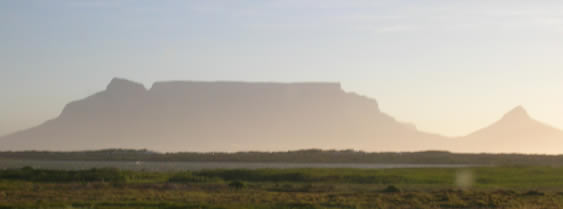
This afternoon I'm off to Stellenbosch and three and a
half days with Wines of South Africa, who have put together a
fantastic itinerary for me. There'll be lots to report on.
Monday 28th November
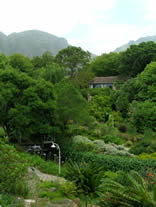 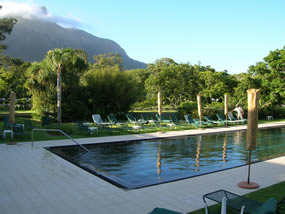 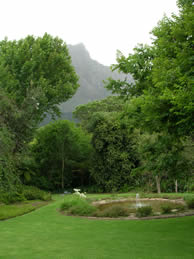
So here I am in South Africa, for a two-part week. The first bit
is science, editing a meeting on innate pulmonary immunity; the second
bit is a busy schedule of producer and vineyard visits. Until
Wednesday I'm staying at the swanky vineyard hotel (pictured) in
Newlands, which boasts fine views of table mountain and a nice
swimming pool. Today I visited my friend Nigel, who I studied with at
University, more years ago than I care to remember. He now works in Guguletu, a township near Cape Town. The contrast between
last night, where we ate in seafood restaurant Baia at the Waterfront,
and Guguletu is striking. Baia was good - perhaps a little more style than substance,
but good food and a nice wine list. We had Graham Beck Brut and then
the Buiten Blanc, both modestly priced. Shame
it was in the middle of a Kingston-style shopping centre.
Thursday 24th November
Walton Heath is a fantastic golf course, but we didn't get to see
too much of it yesterday because of the thick fog. Now my golf needs
all the help it can get, and it didn't get much yesterday. Driving off
into a wall of fog is difficult; approach shots where the green isn't
visible are problematic. I won't tell you my score. But it was good
fun. Tim Atkin won with 34 pts playing off 17. I've yet to go to a
lunch or dinner with Tim where he doesn't walk away carrying a prize -
this time another decanter.
 My
wonderful wife got me a surprise present: one of the new
iPods and the Bose SoundDock.
This has to be heard to be believed: the sound is incredible. I'm not
a terribly techy sort of guy - I do enjoy technology, but I don't go
out and buy myself the latest gadgets. However, the iPod is extremely
elegant and highly functional. Loading up all my CDs will have to wait
until after my South Africa trip, but I'm looking forward to allowing
these fantastic toys to reignite my interest in music, which has faded
a little, by making it more accessible. My
wonderful wife got me a surprise present: one of the new
iPods and the Bose SoundDock.
This has to be heard to be believed: the sound is incredible. I'm not
a terribly techy sort of guy - I do enjoy technology, but I don't go
out and buy myself the latest gadgets. However, the iPod is extremely
elegant and highly functional. Loading up all my CDs will have to wait
until after my South Africa trip, but I'm looking forward to allowing
these fantastic toys to reignite my interest in music, which has faded
a little, by making it more accessible.
As
a nice birthday extra, I found out that Wine
science has just been shortlisted for the 2005 Andre Simon award.
The other three titles vying for this prize (I don't know whether you
get any cash or not, yet) are Hugh Johnson's A Life Uncorked,
Jon Livingstone Learmonth's book on the RhŰne and Constantino
Lazarakis' book on Greek wines.
Tuesday 22nd November
Iím up late again,
writing. Before I go to South Africa I have a few things to finish.
Last night I was revising a Decanter article and penning a
short piece on Portuguese wines for a US publication. Tonight I
finished off a closures overview piece for Harpers and made
good headway on a second piece on synthetic corks. Still to do, a
short piece on GM vines for another US publication and then a
part-complete piece on wine glasses and the perception of wine for Wine
International. Phew. And a website to keep up to date Ė all my
major competitors have their websites as their major focus of
attention, which I envy. I spend a lot of time on wineanorak, which I
am very proud of. But I could do a whole lot more with it, though, if
I had just a bit more time. Still, the competing draws on my attention
help me to be more focused and time efficient. I'm not complaining.
Not at all.
Writing is one of the few
occupations where drinking on the job doesnít necessarily compromise
performance. As I write tonight, Iím sampling (in very moderate
portions) some of the brandies I included in next weeksí Sunday
Express column. Iíve never really drunk brandy before, but
thereís a remarkable affinity between Brandy, Tawny Port and
Madeira, which is the flavour contribution from long ageing in oak
casks. The notes (in the Express)
read as follows.
H
by Hine Cognac Petite Champagne
£19.99 Waitrose
This has a really inviting, almost flowery aroma together with the
more usual cask-like vanilla and toffee notes. Itís smooth, rich and
quite sweet in the mouth with a fresh, rather delicate edge. For
serious sipping while contemplating the meaning of life.
Tesco
Finest VSOP Armagnac
£10.99/50 cl Tesco
Thereís a fresh lemony fruitiness here, which combines well with
some dried citrus fruit, raisin and vanilla toffee character. Itís
bright and quite youthful, with a bit of a zing, but a lovely array of
flavours. Itís quite young, and lacks the mellowness that age
brings, but it makes up for this with a bit of youthful attitude.
Courvoisier
VS Cognac
£17.99 Waitrose, on offer at £14.99
Hmmm, Iím getting orange peel, vanilla, spice, toffee, christmas
cake Ė this really is a beautifully fragrant Cognac. Take a sip and
itís quite soft, warm and spicy, with a nice sweetness on the
finish. One to nurture late into the night, with good friends.
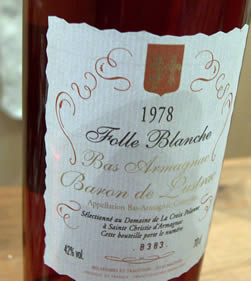 Tesco
Finest 10 Year Old Brandy Tesco
Finest 10 Year Old Brandy
£8.99/50 cl Tesco
A deep coloured brandy thatís been aged for a decade in oak casks.
It has a fresh lemony smell together with some powerful fudge and
vanilla notes. Smooth, sweet and mellow, thereís some complexity of
flavour here. A warm, approachable brandy. Delicious stuff.
Baron
de Lustrac Folle Blanche 1978 Bas Armagnac
£39.99 Oddbins
Were getting into serious territory now. This is expensive, but then
again you wonít glug it down. It has a striking, complex aroma of
limes, orange peel and sweet, spicy fudge and raisins. Itís smooth
and rich to taste with sweet fruit and spice and a long, mellow
aftertaste.
Tomorrow is my birthday, and
rather nicely a suitable jolly has come up Ė golf at Walton Heath, a
serious golf course, with Chilean wine producer Aurelio Montes. Of
course, a lot of the image of golf Ė misogynism, the belief that
social status and driving a nice motor really matter, utter
conservatism, Mason-like favouritism, and hideous fashion sense Ė
utterly sucks. But have you played a beautiful course recently? Itís
a fantastic game, combining a nice walk out of doors with a bit of
easy cameraderie and some mild competition. I also like the wonderful
etiquette and honesty associated with golf. Itís civilized, if a
little bizarre.
Sunday 20th November
Iím knackered. Two days spent sanding floors in the hall and our
two reception rooms has left me physically exhausted, with a sore
right foot and knee from where Iíve been grappling with the edger.
Still another dayís work to finish things off. Glad I donít do
this sort of thing for a living. Had some good wine though, to ease
the aches. Last night it was the Glaetzer Bishop Shiraz 2004,
from the Barossa. A dark, fairly thick wine but certainly not
overstated: thereís a nice freshness to the fruit and everything is
in balance. If Iím going to be really picky, perhaps thereís just
a touch too much vanilla and coconut from the American oak (French is
also used here), but the wine wears it well, and this is a delicious
drop that will age gracefully for perhaps a decade. £15.95 retail,
from Great Western Wines. Languedoc modernists La Baumeís 2004
Viognier is respectable stuff with some lemony freshness adding a
briskness to the otherwise fat peachy Viognier characters. Good for
the price, which is around £4.99 in supermarkets. The La Baume wines
have possibly the cheesiest labels Iíve ever seen (sentimental
photographs of vineyard scenes), but I guess they must be popular with
the average punter. Next up, the ĎAetosí 2003 from
Bordeaux, a super-CŰtes de Castillon made by giants Calvert. When I
opened it last night it was super-tight and not showing much, but
tonight itís delicious Ė still latent Ė but showing some
delicious minerally blackcurrant fruit with good acid and grippy
tannins. This is fairly serious and ageworthy, but last night I
wouldnít have known it, although I did guess. Thereís a lot of
guesswork in tasting.
A couple of completely unrelated comments. Last night
it was interesting to see Parkinson on TV (waiting for Match of the
Day). Iíve never really watched him before, but the last two weeks
Iíve seen his show, and been impressed. He fools people into
thinking heís some genial old duffer, and then comes in with the
sucker punch Ė a proper question. Last week he did a really good
interview of Madonna, and then last night there was a telling
interview with Chris Evans, whoís back after a bit of a personal
belly-up, and Parkie (or is it Parko?) stuck the boot in. Now, as I
write, Iím watching the film Notting Hill (again). I know youíll
think Iím a total saddo, but it really is a fantastic film Ė
clever, funny, accessible, deep, shallow Ė it depends what level you
want to see it on. For me, the fascinating aspect is the way it deals
with the modern obsession with celebrity, and the collision of
celebrity with normal life. It must have been an interesting project
for Julia Roberts, playing herself as an actress, with all the
poignant inferences this must bring.
Friday 18th
November
Yet another good restaurant experience last night. This blog is
getting a bit repetitive, isnít it. [In case you are labouring under
the misconception that my whole life is spent being entertained
lavishly, let me bash that one on the head. Most of my time is
occupied with the humdrum, the ordinary and the unexceptional. Which
is healthy.] This time the venue was the Comptoir Gascon, in
Smithfield, and it was for a Languedoc dinner. The food was superb,
beginning with a delicous scallop/trufflee/foam sort of combination,
followed by the obligatory foie gras, then pigeon, then hare, then a
fantastic cheese course. The wines were good, too. I was sitting next
to Jean-Claude Mas (who makes brilliant commercial wines) and John
Bojanowski of Clos du
Gravillas, both very good company. Iíve
been chatting with John electronically, so it was nice finally to meet
him: he hails from Kentucky, is married to a French woman and makes
fantastic Carignan, as well as an intriguing Grenache Gris. I was
surprised to hear that heís also read my book from cover to cover
Ė itís only been out a short time. Jean-Claude Mas gave me a beret
at the end of the evening, too, with the logo of his Arrogant Frog
brand discreetly embroidered on it. It was very kind of him, but I
donít think Iíll be wearing it that often.
Not
long to go now till my South Africa trip (this time next week). Time
flies. Four articles to finish before I go.
Wednesday 15th November
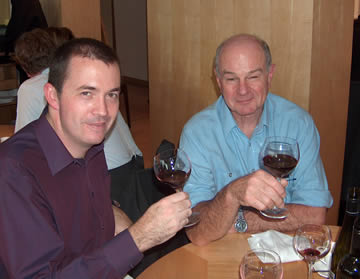 An
interesting afternoon. It began with lunch at celebrity restaurant Nobu
with Phil Laffer (he's on the right, next to me), whoís the
winemaker of Jacobís Creek. For those unfamiliar with Nobu, itís a
seriously swanky Japanese restaurant. Food was superb. Glad I wasnít
footing the bill, though. When Phil joined Orlando in 1991, Jacobís
Creek was a 600 000 case brand. Now itís up to 7 million cases and
growing, but Orlando have an absolute commitment to producing wines
each year that are at least as good as those of the previous vintage.
Their ethos is building the reputation of the brand by focusing on the
quality of what is in the bottle, and it works. Have you tried the
Jacobís Creek wines recently? Theyíre actually pretty good. An
interesting afternoon. It began with lunch at celebrity restaurant Nobu
with Phil Laffer (he's on the right, next to me), whoís the
winemaker of Jacobís Creek. For those unfamiliar with Nobu, itís a
seriously swanky Japanese restaurant. Food was superb. Glad I wasnít
footing the bill, though. When Phil joined Orlando in 1991, Jacobís
Creek was a 600 000 case brand. Now itís up to 7 million cases and
growing, but Orlando have an absolute commitment to producing wines
each year that are at least as good as those of the previous vintage.
Their ethos is building the reputation of the brand by focusing on the
quality of what is in the bottle, and it works. Have you tried the
Jacobís Creek wines recently? Theyíre actually pretty good.
After this delicious lunch I left with a warm glow to
head for Wandsworth, and a screen test with Good
Food Live. Itís the first time Iíve been in a studio for close
on a year, and once again it was quite a fun experience. I had to
present a wine item Ė I took along five different expressions of
Chardonnay, ranging from Chablis to a big Aussie Chardonnay, and did a
seven minute slot to camera. Iíve no idea how it went, but I guess
Iíll find out soon. For the record, the wines I took were: Billaud
Simon Chablis Vaillons 2003; Little Yering Chardonnay 2004; Faiveley
Montagny 2002; Peter Lehman Wildcard Chardonnay 2005; Foile Etante
Chardonnay 2003. Iím enjoying the ride.
Saturday 12th November
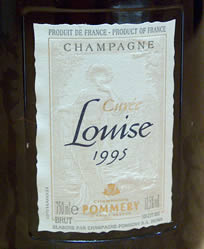 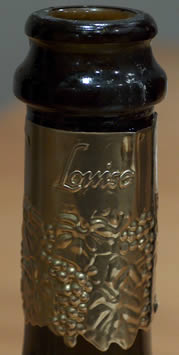 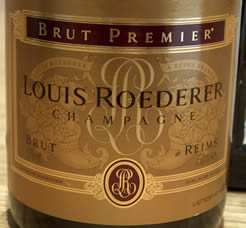
Continuing the fizz fest, a chance to
compare two Champagnes side by side, Louis and Louise. Roederer's
Brut Premier is one of my favourite NV blends. A deep yellow
colour, this deliciously rich NV has a full, warm nose with toast,
herbs and some lemony fruit. The palate shows great breadth, with rich
toasty notes at one end and fresh lemony fruit at the other. A well
balanced and complete wine (widely available for £26.99). Pommery's
Cuvťe Louise 1995 is distinctively packaged with an elegant thin
neck. A yellow/gold colour, this has a lovely smooth, rich nose, with
complex toasty, herb, yeasty and bready notes. The palate is smooth
and full with a herby, toasty richness and an appley character to the
fruit. There are complex savoury notes sitting just above some lemony
freshness - a lovely sophisticated Champagne (this retails at around
£50). Both are impressive wines.
Port season is
almost with us, and my top tip for Christmas glugging is the Quinta
do Noval Unfiltered LBV 1999 (£10.99 Oddbins, Direct Wines). This
is one of the best LBVs, and would put some Vintage Ports to shame.
Great concentration and structure, and stunning value for money. The
1998 is also good (I raved about this last year), if this is still on
the shelves in your local Oddbins.
Thursday 10th November
Yesterday was the Domaines Barons de Rothschild-Lafite
tasting an lunch at the Connaught. It was a good tasting, and I spent
quite some time chatting to the charming Eric de Rothschild, whose
stable of properties covers not just Bordeaux, but also Chile (Los
Vascos), Argentina (Caro, in partnership with Catena), Portugal (Quinta
do Carmo in the Alentejo) and the Languedoc (Ch‚teau
des AussiŤres).
I asked him for his views on wine critic ratings and
points. ĎPoints are good for the industry, but it makes wine
drinking into a bit of a competition rather than a pleasure,í he
said. ĎBut then some people play golf for pleasure, and some for
competitive reasons.í Eric thinks that one of the positive aspects
of points is that a property that performs well can gain a good
reputation even if it isnít from one of the traditionally
high-performing regionsóĎIt wakes people up to the new areas.í
But points have their problems. ĎThere is a negative sideí, says
Eric. ĎFor Bordeaux it tends to put too much emphasis on
extraordinary vintages, and people forget you should be drinking 1997
Lafite nowí. He explained that people are put off wines like the
1997 because this isnít a great vintage, and the wine didnít score
highly. But at the right time an 88 point wine can be a better choice
than a 94-pointer thatís going through an awkward phase and is being
drunk before itís time. ĎItís the Andy Worhol syndrome: just as
everyone has 15 min of fame, wines all have their time when they can
give enormous pleasure.í
This was illustrated by the first of the lunch wines, a 1979 Lafite
from magnum. Not a terribly good vintage but a wine thatís drinking
perfectly now. Not big, but with a charming earthy complexity Ė it
went perfectly with the game pie that was being served. We also had
the 1990 Rieussec. I love old Sauternes, and thisófrom magnum,
againówas also drinking perfectly. As I was preparing to leave
another freshly opened magnum of the Rieussec was dumped on the table.
I was sorely tempted to stay, but I couldnít. Perhaps I made a
mistake.
[Aside: I was chatting to Harpers' Jack Hibberd at lunch. I was
surprised to learn that 1979 was Jack's birth year. That makes him
very young.]
Ch‚teau
Lafite 1979 (from magnum)
Earthy, spicy and evolved, this midweight claret is currently
drinking very well. It has a lovely open palate showing a complex mix
of earth, tar, undergrowth and spice, together with lovely fresh,
quite delicate fruit. This fresh, structured wine is very satisfying.
Sampled from two different magnums, both of which were reasonably
consistent (if anything, the second was slightly fuller and more
fruity). Very good/excellent 91/100
Ch‚teau
Rieussec 1990 (from magnum)
Rather deep orange/brown in colour. Very rich and intense with smooth
honey, apricot and caramel flavours, backed up by tangy acidity.
Itís a wonderfully smooth, rich wine which initially seems a little
one-dimensional, but then shyly opens up to show effortless spicy
complexity. A wine to sip contemplatively. Very good/excellent 94/100
Monday
7th November
Anyone who has paid any attention at all to the news over the last
month or so can't have failed to notice that there's a good deal of
concern over the coming bird flu pandemic. An expert interviewed on
television last night said (remarkably, with a straight face) that we 'shouldn't get
in a flap about it'; I guess this is too serious a subject to be
making a joke out of, but I disagree with this particular expert. Now is the time to make your plans -
but what should they be? It's hard to be sure. Anyone with the
financial means would be well advised to relocate somewhere remote for
a few months when the first dozen or so cases involving human-to-human
transmission occur in the UK, and ride out the devastation that's
almost sure to follow. 2005 seems to be the year when mighty
nations are humbled. In the west we may be prosperous, but our wealth
can't make us immune to natural disasters or viral pandemics. The
complexity of our society (and in particular the retail chain, with
its 'just in time' delivery philosophy) means that it is vulnerable to
disruption. It makes sense, therefore, to be prepared for a degree of
chaos if and when bird flu strikes. We shouldn't panic, but we should
prepare. How though? Suggestions are welcome.
Back
to wine. Tonight, after another hard but enjoyable football session,
I'm drinking a wine that reminds me just why we value Bordeaux so
highly. It's a Haut-Medoc cru Bourgeois (don't you love that term?)
from Ch‚teau d'Arcins 2002 (Oddbins £9.49). This isn't a big
wine; it doesn't have lush, rich, intensely sweet fruit. But what it
does have is a lovely savoury minerality. Think wet pavements, gravel,
earth - and then combine this with slightly tart cassis. The result is
an expressive wine that is easy to drink (certainly not heavy), and
which makes a wonderful companion at table. There's a tiny hint of
greenness that's very appealing. This is what we come to Bordeaux for.
While you should be in no hurry to drink a wine like this, it is
already going down very nicely. By Bordeaux standards, this is very
good value.
Following
a positive response to my note about Champagne below, can I point out
to interested parties reading this blog that my next but one Sunday
Express column is on Brandy. I have a number of examples in
my tasting queue, but anyone wishing to plug their product (assuming
it has reasonable distribution and isn't wildly expensive) will stand
a chance of inclusion if they can get me a sample fairly soon...
Previous entries
Back to top
|